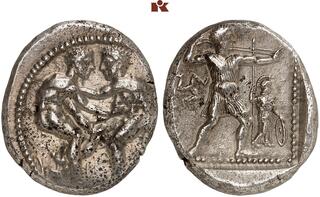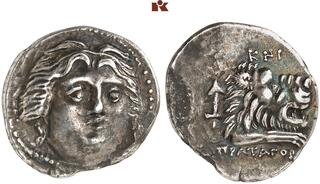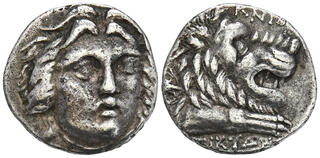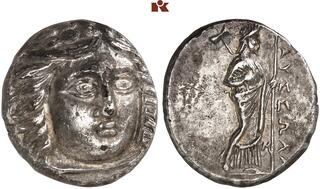Lot description:
PAMPHYLIA. ASPENDOS.
AR-Stater, 420/370 v. Chr.; 10,90 g. Zwei Ringer//Schleuderer r., dahinter Triskelis, davor steht Athena r. SNG Cop. -; SNG France 3, -; SNG v. Aulock 4503 (stempelgleich).
R Avers leicht dezentriert, etwas korrodiert, sonst vorzüglich
Exemplar der Auktion Bank Leu 72, Zürich 1998, Nr. 290.
Gegen Ende des 5. Jhdts. und im 4. Jhdt. v. Chr. wurden ein Ringerpaar auf der Vorderseite und ein Schleuderer auf der Rückseite zum weithin bekannten Design der aspendischen Münzen. Die Ringer werden auf verschiedenen Emissionen in immer wieder unterschiedlichen Kampfstellungen wiedergegeben, doch ist es falsch, in ihnen lediglich einen Hinweis auf die Beliebtheit des Ringersports in Aspendos zu sehen (vgl. richtig Krmnicek 2015). Vielmehr spielen die Ringer auf einen weiteren Gründer von Aspendos an, denn wie die allermeisten griechischen Städte begnügte sich auch Aspendos nicht mit Mopsos als einzigem Gründer. Diese Münzen bilden den Ringkampf des aus Thessalien stammenden griechischen Stadtgründers Polypoites mit einem pamphylischen Lokalherrscher ab. Der griechische Sieger, Polypoites, erhielt das Land um Aspendos. Möglicherweise hieß der im Ringkampf unterlegene Lokalherrscher Aspendos (Hellanikos, FGrHist Nr. 4, F 15 (bei Stephanos von Byzantion, s.v. Aspendos). Wahrscheinlich erscheint er als Repräsentant von Aspendos auf der Rückseite der Münze als Schleuderer. Im griechisch gewordenen Aspendos wurde der Stadtname mit dem griechischen Wort σφενδον?ν/sphendonân, d.h. schleudern, in Verbindung gebracht, so dass man Aspendos als ,Stadt mit dem Schleuderer' verstehen konnte. Die Langschleuder war eine typisch südkleinasiatische Waffe, die auch von den Hirten im gebirgigen Hinterland von Aspendos gegen Wölfe und Viehräuber eingesetzt wurde. Auch wenn diese Münzen mit Ringer und Schleuderer über einen längerer Zeitraum in größerer Zahl geprägt wurden, so unterscheiden sie sich doch durch ihre Beizeichen: Die Pferdeprotome (Nr. 357) unterstreicht, dass Aspendos eine Stadt der Pferdezucht war, die sogar dem persischen Großkönig und später Alexander Tribut in Form von Pferden entrichten musste. Das Beizeichen Athena (Nr. 352) dürfte darauf hinweisen, dass Aspendos von seiner Mutterstadt Argos den Kult der Athena Polias übernommen hat. Die Triskeles ist ein Symbol der Schnelligkeit, das im südkleinasiatischen Raum weit verbreitet war. Besonderes Interesse kann ein recht seltener Ringertypus beanspruchen, unter dem MENETY† EΛARΨΑ zu lesen ist (Nr. 356). Die Deutung dieser Legende ist umstritten, doch lassen sich einige der gemachten Deutungen ausschließen. Am wahrscheinlichsten handelt es sich um den Hinweis darauf, dass eine gewisse Elyssa, die Tochter des Menes, die Prägung dieser Münzserie finanziert hat (zu diesem Typus vgl. Brixhe 1976, 197-199; Tekin 2000). [JN]
Towards the end of the 5th and in the 4th century BC, a pair of wrestlers on the obverse and a slinger on the reverse became the widely recognized design of Aspendian staters. On various issues, the wrestlers were repeatedly depicted in different fighting positions. However, it would be wrong to simply see this as an indication of the popularity of sports and especially of wrestling in Aspendos (cf. Krmnicek 2015). Rather, the wrestlers allude to another founder of Aspendos. Like the vast majority of Greek cities, Aspendos was not content with falling back on Mopsos as its sole founder.
These coins depict the wrestling match between the Greek city founder Polypoites, who came from Thessaly, and a local Pamphylian ruler. The Greek victor, Polypoites, received the land around Aspendos. It is possible that the local ruler who lost the wrestling match was called Aspendos (Hellanikos, FGrHist No. 4, F 15 in Stephanos of Byzantium, s.v. Aspendos). He probably appeared again as a representative of Aspendos on the reverse of the coin, in this case as a slinger. In Aspendos, which had become Greek, the name of the city was associated with the Greek word σφενδον?ν/sphendonân, i.e. to sling. This means that Aspendos could be understood as the 'city of the slinger'. The long sling was a typical weapon in southern Asia Minor, and also used by shepherds in the mountainous hinterland of Aspendos to protect themselves against wolves and cattle raiders (Korfmann 1972). Even though coins depicting wrestlers and slingers were minted in large numbers over a long period of time, they differ from each other in terms of the icons placed beside the slinger: The horse protome (No. 357) emphasizes that Aspendos was a city of horse breeding, which even had to pay tribute in the form of horses to the Persian Great King and later to Alexander. The Athena icon (No. 352) probably indicates that Aspendos adopted the cult of Athena Polias from its mother city Argos. The triskeles was a widespread symbol of speed in southern Asia Minor. A rather rare type of wrestler with the legend MENETY† EΛARΨΑ below the depiction is of particular interest (No. 356). The explanation of this legend is controversial, but some of the interpretations that were put forward can be ruled out. It is most likely that a certain Elyssa, the daughter of Menes, financed the minting of this coin issue (on this type see Brixhe 1976, 197-199; Tekin 2000). [JN]
Estimate: 200 EUR |  |










